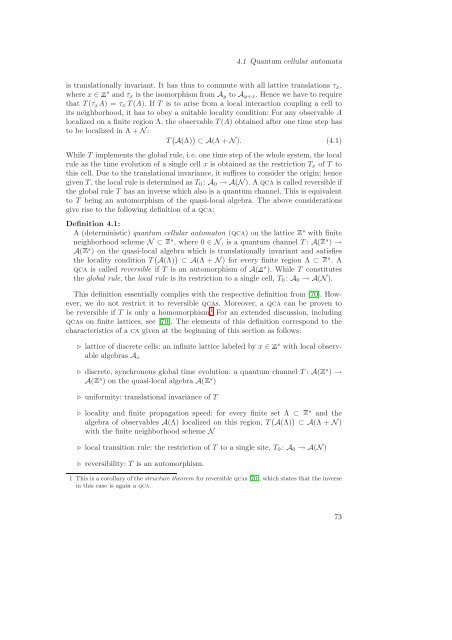Quantum Information Theory with Gaussian Systems
Quantum Information Theory with Gaussian Systems
Quantum Information Theory with Gaussian Systems
You also want an ePaper? Increase the reach of your titles
YUMPU automatically turns print PDFs into web optimized ePapers that Google loves.
4.1 <strong>Quantum</strong> cellular automata<br />
is translationally invariant. It has thus to commute <strong>with</strong> all lattice translations τx,<br />
where x ∈s and τx is the isomorphism from Ay to Ay+x. Hence we have to require<br />
that T(τxA) = τx T(A). If T is to arise from a local interaction coupling a cell to<br />
its neighborhood, it has to obey a suitable locality condition: For any observable A<br />
localized on a finite region Λ, the observable T(A) obtained after one time step has<br />
to be localized in Λ + N:<br />
T A(Λ) ⊂ A(Λ + N). (4.1)<br />
While T implements the global rule, i.e. one time step of the whole system, the local<br />
rule as the time evolution of a single cell x is obtained as the restriction Tx of T to<br />
this cell. Due to the translational invariance, it suffices to consider the origin; hence<br />
given T, the local rule is determined as T0: A0 → A(N). A qca is called reversible if<br />
the global rule T has an inverse which also is a quantum channel. This is equivalent<br />
to T being an automorphism of the quasi-local algebra. The above considerations<br />
give rise to the following definition of a qca:<br />
Definition 4.1:<br />
A (deterministic) quantum cellular automaton (qca) on the lattices <strong>with</strong> finite<br />
neighborhood scheme N ⊂s , where 0 ∈ N, is a quantum channel T : A(s ) →<br />
A(s ) on the quasi-local algebra which is translationally invariant and satisfies<br />
the locality condition T A(Λ) ⊂ A(Λ + N) for every finite region Λ ⊂s . A<br />
qca is called reversible if T is an automorphism of A(s ). While T constitutes<br />
the global rule, the local rule is its restriction to a single cell, T0: A0 → A(N).<br />
This definition essentially complies <strong>with</strong> the respective definition from [70]. However,<br />
we do not restrict it to reversible qcas. Moreover, a qca can be proven to<br />
be reversible if T is only a homomorphism. 1 For an extended discussion, including<br />
qcas on finite lattices, see [70]. The elements of this definition correspond to the<br />
characteristics of a ca given at the beginning of this section as follows:<br />
⊲ lattice of discrete cells: an infinite lattice labeled by x ∈s <strong>with</strong> local observable<br />
algebras Ax<br />
⊲ discrete, synchronous global time evolution: a quantum channel T : A(s ) →<br />
A(s ) on the quasi-local algebra A(s )<br />
⊲ uniformity: translational invariance of T<br />
⊲ locality and finite propagation speed: for every finite set Λ ⊂s and the<br />
algebra of observables A(Λ) localized on this region, T A(Λ) ⊂ A(Λ + N)<br />
<strong>with</strong> the finite neighborhood scheme N<br />
⊲ local transition rule: the restriction of T to a single site, T0: A0 → A(N)<br />
⊲ reversibility: T is an automorphism.<br />
1 This is a corollary of the structure theorem for reversible qcas [70], which states that the inverse<br />
in this case is again a qca.<br />
73
















